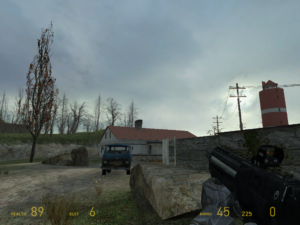Half-Life 2: Ha-ha
 It turns out that Half-Life 2 does have a lot of open-air scenes after all. It’s also a very linear game, but the line varies in thickness: sometimes you’ll be out driving a vehicle (I’ve used a fanboat and a dune buggy so far, both of which look like they’re made of scrap metal), with a large area around you to do wide turns in, and suddenly your path will be blocked by a gate that can only be removed by throwing a switch inside a nearby building at the end of some small rooms and twisty hallways.
It turns out that Half-Life 2 does have a lot of open-air scenes after all. It’s also a very linear game, but the line varies in thickness: sometimes you’ll be out driving a vehicle (I’ve used a fanboat and a dune buggy so far, both of which look like they’re made of scrap metal), with a large area around you to do wide turns in, and suddenly your path will be blocked by a gate that can only be removed by throwing a switch inside a nearby building at the end of some small rooms and twisty hallways.
When you’re outside, the game does its best to give an impression that the environment is larger than it actually is, and that you have more options than you actually have. Obviously it isn’t just FPS games that try to do this: adventures have been creating the illusion of rooms just out of your reach since the intro to Planetfall. What it means in Half-Life 2 is that attempts at exploring the periphery loop back fairly quickly, and the game takes advantage of the beefiness of its graphics engine to render unreachable scenery objects in full detail out to a considerable distance. I haven’t encountered the “invisible wall” effect found in many other games, constraining you when you stray from the path by halting your forward movement for no obvious physical reason, but there are lots of places that look like they’re passable until you’re very close, at which point it’s clear that the slope is too steep or the gap is too wide or whatever.
It reminds me of a landscaping technique sometimes called a “ha-ha”. A ha-ha is essentially an inconspicuous ditch or drop-off with a retaining wall. The idea is that it gives you a seemingly-continuous view from your manor window of verdant pastures unmarred by fences, but still keeps the cattle off your croquet lawn.
But, although the player’s view in Half-Life 2 is the illusory continuity seen from the manor house, you’re not on the high ground. The ha-ha is there to limit you. Thus, the level designers of Half-Life 2 treat the players like cattle.
 Comments(2)
Comments(2)
While I miss the days of the non-linear FPS games, I think the way linearity is handled in Half-Life 2 is head and shoulders above the efforts of something like Doom 3.
While HL2 does push you along corridors, you’ll eventually emerge within a large arena that offers considerable scope to experiment with different approaches. I won’t mention anything specific, seeing as you’re only a short way into the game, but this will become apparent as you progress. HL2E1 & HL2E2 go even further in this respect.
On the other hand, a game like Doom 3 rarely offers these sorts of arenas, confining the gameplay to corridors or corridors disguised as rooms.
Still, developers are stuck between a rock and a hard place. They want gamers to play a game through to the end, but statistically very few actually do. Even for relatively shorter games like HL2E1 (which can be completed in about 4-6 hours), Steam’s stats show that only a small percentage of players actually played them through to the end.
What’s a developer to do? Give hardcore players a non-linear environment and risk alienating the remaining 90% to the extent that they don’t get more than halfway through the game? Let’s not forget the number of man hours that go into creating all the assets for a given level. Make the level non-linear and you end up consuming expensive resources to produce something that many gamers might not actually see.
I think it’s quite telling that many HL2 players desperately *want* to see and explore more of City 17 and its surrounding environs. Is that because Valve did such a great job with the world-building and ambience of the game, or is it more to do with our built-in desire to explore and discover the new? HL2 certainly had me wanting to jump the invisible fence a lot more than its contemporaries.
And then there’s Far Cry — a non-linear FPS gamer’s wet dream. If you never tried it, I strongly suggest picking it up, especially now it’s going for less than ten bucks on Steam.
“Thus, the level designers of Half-Life 2 treat the players like cattle.”
It’s something that bothers me about Valve’s design philosophy. There’s been something of a disquiet in my mind ever since I head Kim Swift and Erik Wolpaw talk about how much they threw away in the playtesting of Portal; I’m also told that Valve games are linear by fiat because they consider it a waste of resources to make content that players might not see. (This seems like it’s a contradiction to me.)
There is something to be said for confusion. Perhaps not in an FPS – or perhaps so, Half-Life has always been more cerebral than most shooters.